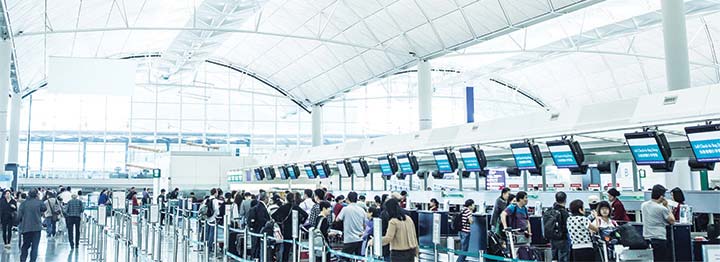Sometimes good is no longer good enough. Sometimes it is a sign of complacency, and in order to avoid future obsolescence, a shake-up becomes necessary.
Such was the case for Sabre Travel Network. Although the company’s top-line business had been consistently profitable, in 2015 the CEO of parent company Sabre Corp. decided that to drive long-term growth, the $3.2 billion technology company needed to reassess and sharpen its value proposition. Sabre Travel Network would be a key contributor to that growth.
For decades, Sabre Travel Network has connected travel buyers (corporate travel departments, travel agents, individuals) with travel sellers (airlines, hotels, car rental companies) through its global distribution system (GDS). Whenever someone makes a reservation on Expedia, for example, Sabre is the behind-the-scenes platform that makes that transaction possible. The Southlake, Texas-based company has offices on five continents and handles around 100,000 data transactions per second; it is the leading provider of air bookings in North America.
Sabre’s executive team was convinced Sabre Corp. was not reaching its true potential and had grown complacent. The CEO wanted to put to rest any doubts about the value of its GDS: Some naysayers called it a “dumb pipe,” mere middleware that facilitated transactions but did not add real value. To catalyze a leap in the Travel Network business and help Sabre Corp. fulfill on the opportunity in front of it, Wade Jones was brought on in 2015 to identify how Travel Network ought to transform itself and then be the change-maker that pushes the company toward bold financial goals.
“Just because our results were good didn’t mean we shouldn’t aspire for better.”
-Wade Jones, Sabre Travel Network
“Just because our results were good didn’t mean we shouldn’t aspire for better,” says Mr. Jones, Travel Network’s senior vice president of marketing and strategy. “We were under-leveraging the assets we had—meaning we could be bigger and more profitable. We wanted to make sure we weren’t complacent. Share on X”
“Wade brings new thinking to an already strong organization,” says Scott Beckett, a partner with Insigniam who works closely with Sabre. “His ability to see new horizons and opportunities was a real complement to Sabre’s innovative and growth-minded culture.”
In his almost three-decade career, Mr. Jones had often helped organizations in crisis make immediate and radical changes to survive. Such companies had “a burning platform” for change, he says. But the situation at Sabre was different—and that attracted his interest. “What appealed to me about Sabre when I walked into it was that it was a very successful company that had a desire to drive more growth using a profitable underpinning,” Mr. Jones says.
Not too long after joining the company, Mr. Jones’ direct boss—and the president of Travel Network—retired. Sabre named Sean Menke, a longtime and highly successful airline executive, as the new president of the division. Mr. Menke and Mr. Jones quickly found common ground. The pair knew they had time, but not much, to make things happen: Sabre had given them just a three-year window to make the necessary transformational changes, whatever they might be. “Nobody was prescriptive about how we should go about doing it,” Mr. Jones says. “To me, that’s where the fun work is.”
A Three-Point Plan
To determine where exactly the organization needed to go, Mr. Jones and his strategy team first had to understand where it was. To start, he went on a listening tour, meeting with employees throughout Sabre as well as its customers. Mr. Jones asked two simple questions: What is Sabre doing well, and what could it do even better? “I didn’t look for anyone to be held accountable for what was wrong. But you have to get the truth out on the table,” he says.
After just one week of these conversations, Mr. Jones identified three key things Sabre needed to do: better leverage its data and analytics, break down its organizational silos and develop a clearer sense of its purpose and value proposition.
“Sabre is the clear market leader in several critical segments, and with such success comes competitors desperate to steal share and topple the leader from its perch,” Mr. Beckett says.

Sabre has a treasure trove of data and analytics, Mr. Jones says, “but we weren’t turning that into insights and taking action based on it.” So he decided to push the company to deepen its understanding of exactly how customers use its platform and how their activity creates the most value and profit. Then Sabre would be armed with the right insights to decide how to improve features and how to price them.
The company’s ability to optimize product investments to power growth hooked directly to Mr. Jones’ next goal: breaking down silos. The organization’s three distinct business units were obstacles to strategic innovations, in his view. He spotted a major opportunity: “We could collaborate more effectively, particularly with our colleagues in technology, product development and sales,” he says.
Sabre had been divided into three product areas: The first was responsible for managing the content sold through the network, the second for making that content available to customers and the third for fulfilling customer transactions. While those units remain, Mr. Jones recommended restructuring them to drive interactions.
“They now have to work across the three parts of the value chain,” he says. Whereas before a product team would hand off requirements for a new feature to the technology team, those teams now work closely together. “Everybody should feel like they have skin in the game on behalf of our customers Share on X,” Mr. Jones says.
“Our customers are very good at what they do, but our role as a business-to-business partner is to help them be more successful.”
To further break down divisions within the company, Travel Network handed decision-making powers around product capability and marketing to regional offices. Mr. Jones admits, “I don’t believe in the ivory-tower thinking that innovation comes only from headquarters or the product team.”
“One of Sabre’s key assets is its relationship with its customers and its awareness of the realities happening in the markets of its customers,” Mr. Beckett adds. “Sabre’s challenge was to leverage scalability without forsaking the necessary customization appropriate to its customers and their markets.”
Breaking down silos set the stage for the third piece of Mr. Menke’s and Mr. Jones’ transformational playbook: refining Sabre Travel Network’s purpose, strategy and vision for the future. In the past, the organization had primarily focused on making sure its platform’s offerings kept up with competitors and pleased all customers. The downside to that approach was that “when you make everybody a little bit happy, no one’s happy,” Mr. Jones says. The solution: Rather than trying to provide everything to everyone, Sabre needed to be more selective and strategic, with a laser focus on features that drive value to customers.
To learn what was most important to customers, Sabre conducted interviews with hundreds of them around the world over 12 months. This process revealed that both travel agents and suppliers wanted greater personalization of merchandise—that is, the ability to get the right travel product to the right buyer at the right time. They wanted automation of non-value-adding platform features. Travel consultants wanted to spend more time doing what they are good at: selling travel.
Building off the clear need to boost those capabilities, Sabre’s new purpose and value proposition came into focus. Ultimately, it was about deepening the commitment to customers’ success, Mr. Jones says. “Our customers are very good at what they do, but our role as a business-to-business partner is to help them be more successful.”
The Art of Change-Making
 With the course forward charted, the real challenge for Travel Network was now at hand: Sabre’s recent rosy performance contributed to a good-enough mentality, at least among some employees, Mr. Jones says. “When you’re actually outperforming prior expectations, there can be a mindset of, ‘Well, why do we have to do better?’”
With the course forward charted, the real challenge for Travel Network was now at hand: Sabre’s recent rosy performance contributed to a good-enough mentality, at least among some employees, Mr. Jones says. “When you’re actually outperforming prior expectations, there can be a mindset of, ‘Well, why do we have to do better?’”
But from his perspective, the stakes could not be higher. “If people are predicting your demise, that should be a motivator to make sure you are innovating and driving value,” he says, referring to critics saying Sabre’s market-maker business model needed to be disrupted. “You have to expand your value from just core services so that you protect the future of the business model.”
While support for the transformation of Travel Network from the CEO and the rest of the executive team was indispensable, it alone could not bring adequate buy-in for change. “Any time you’re trying to drive change, you have some people who aren’t on board with it, some who are on the sidelines with a wait-and-see mindset and some who are totally on board,” Mr. Jones explains. To drive more people into the latter category, Travel Network executives looked to get some early wins. “That can make the highly engaged people almost like disciples for the new approach,” he says. Employees quickly saw the value, for instance, of more fine-tuned data and analytics and more disciplined product governance.
Travel Network further secured buy-in from employees by not taking on too much too soon. Mr. Jones focused his strategy rollout plan around the three defined areas rather than trying to optimize every corner of the company. “That way, rather than overwhelm ourselves,” he says, “we built organizational muscle memory we could then use on the next set of building blocks.”
Crafting the Team
Throughout the process, Mr. Jones has not shied away from ensuring the right people are on board to meet new demands. Empowered by Mr. Menke to build a world-class team, Mr. Jones knew he needed to make changes if employees did not have the necessary skill set to help move the organization forward. While letting some employees go and hiring others, Mr. Jones made a point of assuring his steadfast workers they were doing well. “It’s really important to make sure that those who remain don’t feel rattled or uncertain,” he says. “You want to give them as much clarity as you can so they’re motivated.”
By shaking up his own group first, Mr. Jones intended to set an example for his peers, including the heads of finance and technology. “I made a lot of changes within my own area that were influenced by the feedback I got from people in other areas,” he says. “People saw that I wasn’t taking an arrogant point of view—that making change was everybody else’s problem.”
“Wade’s leadership in first focusing on his team demonstrated his awareness that Sabre needed to change everywhere, and he was not going to ask others to do what he would not do himself Share on X,” Mr. Beckett says.
Reward and recognition have been a big part of driving change—the “fastest way to change any organization,” Mr. Jones says. “I’m a big believer in rewarding your best people disproportionately. That motivates the ones doing well to do even better and spurs the ones not yet at that level of performance by letting them know exactly what they need to do—and what they have to gain by doing it.”
Two years into the three-year journey, Mr. Jones remains clear-eyed about the transformation Travel Network is undergoing. Recently, Mr. Menke was promoted to lead the whole of Sabre Corp., leaving the team in Travel Network to go forward vigorously, as planned. “Transformations never go as fast as you want them to,” he says. “I’m always amazed when people say all they need is a clear strategy. You can have a great strategy, but if you don’t have a plan and you don’t execute it, strategy doesn’t matter.”
Postscript: As of January 1, Sean Menke now serves as president and CEO of Sabre Corp. Wade Jones has been named the interim president of Sabre Travel Network.






